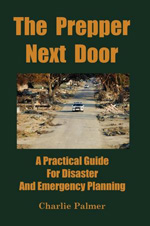There are many rifle calibers called 7.62 mm times something. There is the powerful 7.62 mm x 51, which I just call the 7.62 NATO. There’s the 7.62 x 39 mm, the caliber of the AK-47. There’s the 7.62 x 54R, which is used in the Mosin Nagant, which judging from youtube videos, is surprisingly popular among preppers. The R doesn’t stand for Russian, but for Rimmed. There are other calibers commonly designated with a 7.62 mm size, but we’ve hit the main ones preppers use. The 30-06 is also a 30 caliber, obviously.
For rifle buffs, the plethora of 6.5 mm calibers was always fun and confusing. There was the 6.5×55 mm Swedish, the 6.5x54mm Mannlicher, and the 6.5x52mm Mannlicher-Carcano (Lee Harvey Oswald). There is also, apparently, a Dutch 6.5x53mm which I’ve also heard called the 6.5x53R, and the Russians contributed the 6.5x54R, which is the 7.62x54R necked down, although I’ve never seen one of those. Many newer 6.5 mm calibers exist.
My point: We need another 7.62 mm chambering. When the 7.62 NATO was developed, the goal was to equal the power of the 30-06. The project started with the 300 Savage. The neck was improved for automatic rifle feeding and the case made longer.
What I think would have been neat would have been a shorter version of the 7.62 mm NATO, made to match the overall length of the 300 Savage. Instead of aiming for the power level of the 30-06, accept a new autoloading caliber with the power level of about the 30-30. Just improve the neck. That would be a U.S. equivalent of about the Russian 7.62×39 mm. It would be adequate for most things.
The advantage of this new caliber (let’s call it the 308 Palmer) would be reduced recoil, the same reason so many rifle shooters love the family of 6.5mm rifles. I started thinking about this while leafing through the Grizzly (grizzly.com) catalog. If you spend a few thousand dollars to purchase one of their high-quality gunsmith lathes, they’ll toss in a free DVD about how to make a match grade barrel.
Making and rifling a barrel would be no small undertaking, but if I had the time and money, this would be a very cool project. Many preppers said they wanted a take-apart Ruger 10/22 years before Ruger came out with one.
In a world where you had complete design freedom, what ultimate survival gun would you design or like to see made? What features would you want to see incorporated into an existing design?
Although most preppers, myself included, won’t be building barrels anytime soon, for those who want to learn more about gunsmithing, the founder of midwayusa.com has a nice Youtube channel. He has videos showing how to make and fit small gun parts.
In the book, I said some machinists make their own AR-15 receivers. A project that looks much easier (almost embarrassing easy for a serious metal smith) is bending and drilling a AK-47 receiver. This guy started with a blank that was already bent.
Gunsmithing skills aren’t necessary for a prepper who plans for short- and intermediate-term disasters. For many preppers, if half their weapons broke down, they’d have plenty of firepower left. But for long-term preppers, it’s one more thing you might want to study. It can be a fun hobby.
***
I stumbled upon this interview. A kid interviews his mom about her favorite preps. When asked what her favorite preps are, she replies: “…my dutch ovens, my 16×20 tent with a stove and water heater, the WonderWash, porta-potty and a tent to put it in, a way to shower with warm water, the Volcano II cooker and dutch oven table.”
You had me at porta-potty. How many preppers have twenty rifles, 10,000 rounds of ammo, and can generate their own electricity with solar power, but they plan to rely on a seat with a hole in it and a pair of folding legs as their main toilet?
The “WonderWash” was new to me, so I got to googling. It’s a tiny camp washing machine that is hand cranked. Here it is on youtube. It looked a bit fragile.
Other preppers on Youtube were busy planning for how to deal with laundry in a long-term crisis. LDS Prepper has this video. TNgun has this post.
When I get work clothing really grimy, greasy, and full of oil and other car fluids, I put it in a bucket and add Tide. Let it soak and then turn it over several times by hand. Then, ring it dry. Ringing it dry is a great forearm workout. I’d never put clothing that greasy into a washing machine. This wouldn’t be my preferred method for cleaning reusable diapers.
In a true long-term situation, I’d try to rig up something like this with an exercise bike. Pedaling your laundry clean would take far less energy than hand cranking it.
I must confess, I had a manual washboard and some sort of contraption that wrung water out of clothing, but in my plan to de-clutter, I tossed them out.
Tags: Gunsmithing, SHTF Appliances
